Neal Thompson's Blog: Blood & Whiskey, page 8
May 6, 2013
A WTF! Q&A with Ripley’s Believe It or Not!
Well this was fun… chatting with the Ripley’s Believe It or Not! folks for their cool WTF! blog. (No, it actually stands for Weird True Facts.)
Re-purposing the interview. Thanks for the great questions Suzanne!
Q: What sparked your interest in Robert Ripley? Why write a biography on him?
Neal: For starters, I was shocked and psyched to learn that no full-fledged biography of Ripley had even been written. I discovered this one day in 2007 when I read a New York Times article about the opening of a Ripley’s museum in Times Square. The story included only a brief mention of Ripley, but it was the first time I had given any thought to the real man behind the Believe It or Not franchise.
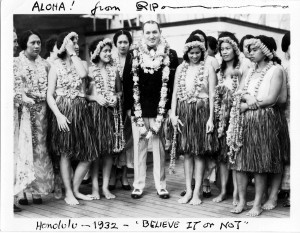
Ripley in Honolulu, Hawaii
That’s the day (August 24, to be exact) that Ripley’s overlooked story became my obsession. I also became hooked on the fact that Ripley had such a lasting influence on pop culture. You can see it all around: America’s Funniest Home Videos, Mythbusters, Jackass, Fear Factor, Survivor, The Amazing Race, even Oprah and Dr. Phil. As I argue in A Curious Man, he was sort of the godfather of the reality TV phenomenon of recent years.
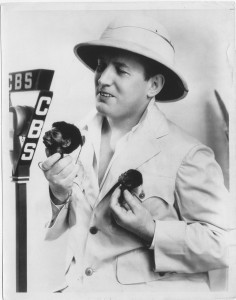
Ripley with two shrunken heads
Q: Do you have any personal history with Ripley’s? For instance, did you read the cartoons growing up or have you been to a museum?
Neal: The first 15 years of my writing career were spent as a newspaper reporter, so that was my first exposure to Ripley. I had also read the occasional Believe It or Not books as a kid, but I had always been a fan of the funny pages – even before my journalism career – so I had kind of soaked up the Ripley vibe: the appreciation for the strangeness of the world, and for the weird things people do for kicks.
Q: Your narrative is so rich and full of small details. What was your research process like? How did you capture of the essence of his era in your writing?
Neal: Again, my journalism background came in handy here. I really enjoy the research part of a book project. I love playing detective and digging for clues. And I strongly believe that aggressively and meticulously researched stories allow a writer to do more with the storytelling.
I received a lot of help in this regard from the Ripley Entertainment company, whose archive of Ripley materials was a treasure trove. I spent many hours there, reading Ripley’s own handwritten notes and travel journals. I read his first impressions of Baghdad and his remorse after a drunken night in Johanessberg, for example. Getting those intimate, first-hand details was invaluable when it came to the writing.
As for my process, I’m a big fan of the three-ring binder. I think I filled about fifty of them for this book. I’ve since donated them to the Ripley archives. I still kind of miss them.
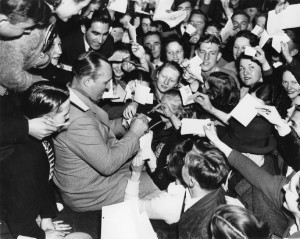
Ripley surrounded by a throng of fans
Q: You studied every facet of Ripley’s life. What was your favorite story or fact about Robert Ripley?
Neal: Oh, there are so many, it’s hard to narrow it down. I have a few favorites, though. For example…
Ripley traveled more than 100,000 miles in 1933-34 alone, but never drove a car.
He once bumped into Will Rogers at a bazaar in the middle of the Syrian desert, en route to Baghdad.
Though shy and bucktoothed, Ripley became a renowned ladies man who sometimes had a few girlfriends living with him at one time—an actual harem.
At his private island and mansion, he’d host days-long Hefneresque parties.
As a radio pioneer, Ripley once broadcast a show from the bottom of the Grand Canyon, an event that helped launch Barry Goldwater’s political career.
Ripley was the model for Bugs Bunny’s nemesis, Elmer Fudd.
Even his final resting place has an eccentric twist: he’s buried at Odd Fellows Cemetery.
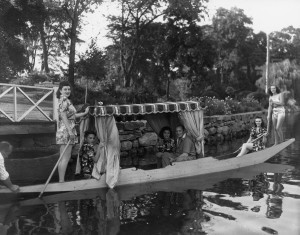
Ripley with his ‘harem’ of women
Q: Ben Fountain was quoted as saying “Anyone who wants to understand America needs to read this book” – What do you think he meant by this statement?
Neal: I think he’s referring to Ripley’s influence on pop culture, how he gave his fans what they wanted – a titillating look at bizarre people and accomplishments. He loved to shock people, and he know his followers wanted to be shocked. But he also loved proving that his shockers were true. That taste for the strange-but-true, the stranger-than-fiction, the unbelievably true… those are all at the core of the reality TV phenomenon, again, from Mythbusters to Jackass to Fear Factor. So I think Ben was commenting on what another early Curious Man reviewer (David Shields) said: “the world Ripley created is the world in which we now live.”
Q:What was your biggest takeaway from the book?
Neal: My biggest take away – and this is what I hope readers will experience – is that Ripley enjoyed life, was constantly amazed by it. So for me, it was amazing to experience the wild ride of Ripley’s rambling life and over-the-top lifestyle, and I hope readers will experience the same unexpected sense that I developed, which is that Ripley’s influence is all around us, sixty-plus years after his death.
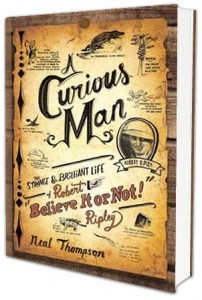
GET YOUR COPY TODAY

May 1, 2013
My Q&A with Pulitzer Prize winner Jon Meacham
J.M. - What led to the moment when you decided that this was the right book to do?
N.T. – Someday I need to buy Edward Rothstein a drink, or give him a hug. His 2007 New York Times story about a new Believe It or Not! museum in Times Square, and the man behind it—“a cross between the Coney Island barker and the cultural anthropologist”—set me on the five-year path to this book. From that article, I learned that Ripley was far more than a cartoonist. In his day, he was among the wealthiest men in entertainment, among the most popular and best-traveled men in America. And yet his over-the-top life story had never been fully told. I was instantly hooked, and my inspiration became an obsession. It was a life-changing moment, when I realized: this . . . this is my story.
J.M. - What surprised you the most in the research?
N.T. – I had a general sense of Ripley’s appreciation for the so-called “freaks” that have anchored the Believe It or Not brand. But I was thrilled to learn that Ripley was hardly a Barnum-style exploiter. In fact, he was a compassionate champion of those whose weirdness defined them. As a shy and bucktoothed oddball, I found that his devotion to strange people and the strangeness of the world grew from his own sense of being a bit of a misfit. He was the underdog who celebrated underdogs. I was equally thrilled to learn that this passion for discovering the overlooked and the outcast made him fabulously rich and famous.
J.M. - What, if any, enterprise in our own time most resembles the role Ripley’s played in the culture in its heyday?
N.T. – It’d be impossible to find a modern equivalent, and I’ve often wondered if Ripley, who thrived in a pre-TV era, would find an appreciative audience in today’s screen-centric, beauty-obsessed culture. He was a goofy looking dude, and not entirely comfortable as a public figure. Yet, remarkably, he was a multimedia pioneer, on radio and TV, usually thanks to his nerve-taming paper cups of gin or whiskey. Today, what most resembles Ripley is a mash-up of pop-culture personalities and phenomena: Anthony Bourdain, Andrew Zimmern, Oprah, Dr. Phil, The Amazing Race, MythBusters, and Fear Factor.
J.M. - What was the secret to Ripley’s empire? Why did it thrive where and when it did?
N.T. – One thing I love about Ripley’s life story is that this strange and restless guy turned his curiosity about the world into an empire: a syndicated cartoon, bestselling books, top-rated radio shows, lectures, museums, and some of the first episodic TV shows. And for most of his prime years, the rest of the nation was suffering the effects of the Depression. But it turned out that Ripley’s dispatches from all corners of the globe were exactly what America needed at the time. And, I’d argue: today, we still do.
J.M. - What do you hope readers take away from the book?
N.T. – Mainly I hope people will be inspired by Ripley. In all of my books, the real-life characters share an underdog quality. Having grown up with a sister who had a disability (Down syndrome), I’ve always been drawn to those who overcome some hardship or setback, who challenge themselves and achieve something remarkable. In Ripley’s case, he enjoyed life to the extreme and was constantly amazed by it. And I hope readers will enjoy the wild ride of Ripley’s rambling life and eccentric, lavish lifestyle while also discovering (as I did) that Ripley’s influence is all around us, sixty-plus years after his death.
April 30, 2013
Jane Smiley and Ohio like Ripley
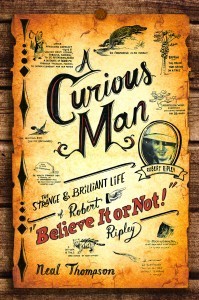 Just a week until publication day, and already A CURIOUS MAN is getting some early buzz. It was the lead book review in Harpers, taking up nearly a page and a half and reviewed by Jane Smiley - Jane Smiley! Here’s a snippet (warts and all): “Thompson’s spirited but uneven biography charts Ripley’s rise as a popular phenomenon, a deeply idiosyncratic personality who — through newspapers, radio, film, and, at the very end, television — wedded his restless obsessions to the rise of mass culture … Ripley was a popular game changer.”
Just a week until publication day, and already A CURIOUS MAN is getting some early buzz. It was the lead book review in Harpers, taking up nearly a page and a half and reviewed by Jane Smiley - Jane Smiley! Here’s a snippet (warts and all): “Thompson’s spirited but uneven biography charts Ripley’s rise as a popular phenomenon, a deeply idiosyncratic personality who — through newspapers, radio, film, and, at the very end, television — wedded his restless obsessions to the rise of mass culture … Ripley was a popular game changer.”
On Sunday, the Columbus Dispatch devoted nearly a full page, calling A CURIOUS MAN “an engaging, fast-moving biography…makes the case that Ripley was among the first media celebrities, and that his affection for the grotesque and the extreme shaped American pop culture.”
Other early reviews:
“Robert Ripley was as unique and fascinating as the ‘Believe It or Not’ newspaper feature that made him one of the most popular and widely read syndicated cartoonists in the country during the 1930s, and Thompson delivers an equally fascinating biography that captures the influence of Ripley’s work life then and now, well into the age of television and the Internet ….Thompson superbly shows how Ripley’s work is the basis for today’s more extreme reality shows by teaching readers ‘to gape with respect at the weirdness of man and nature.’” –Publishers Weekly
“Thompson paints a picture of Ripley as a brilliant but aggressively eccentric man, a globe-trotting curiosity seeker who always believed there was something even more unusual just around the corner. A Curious Man is a fine introduction to a man who, for most of us, has been merely the name above a famous title.” –Booklist
”Ripley’s amazing American life itself plays out like an impossible fairy tale.” –Kirkus
Stay tuned for more…
March 2, 2013
A review of the heartbreaking WAVE, by Sonali Deraniyagala
My rating: 5 of 5 stars
My Amazon Best Book of the Month review: In an unblinking act of storytelling, Sonali Deraniyagala ruthlessly chronicles the aftermath of the 2004 tsunami that horrifically snatched from her all that mattered. Throughout this fierce and furious book, I kept wondering how someone who lost so much could write about it with such power, economy and grace. At first, she shrieks and grieves openly, angrily; for years she remains stunned and staggered, shamed by “the outlandish truth of me.” Then, slowly, she allows herself to remember, sharing vivid glimpses of her past. We see, hear, and smell two rowdy little boys, their brotherly scuffling, their muddy shoes and grass stains. By confronting and recreating moments that make us laugh and weep, we accept their absence and root for the author not to quit. Difficult to describe, tricky to recommend, this is a bold and wondrous book. In a wounded voice that manages to convey the snide, sarcastic, funny, and fatalistic personality that survives beneath the pain, Deraniyagala slowly pieces together the elements that represent the life–the lives–she lost. And she brings them back. For us, for her, for them. So brave, so beautiful, in these pages Deraniyagala’s family is brilliantly alive. And so is she.
–Neal Thompson
For fans of
The Year of Magical Thinking
and
The End of Your Life Book Club
[More Amazon Best of the Month reviews here: amazon.com/nealthompson]
February 2, 2013
Adam Mansbach’s “Rage is Back”
 Rage Is Back by Adam Mansbach
Rage Is Back by Adam Mansbach
My rating: 4 of 5 stars
My review from Amazon Best Books of the Month, January 2013: In a show of literary multidexterity, the author of the best-selling faux children’s book Go the F**k to Sleep has written a sassy, snarky homage to ’80s-era graffiti artists and the city that was their canvas. Mansbach wields a jazzy, poetic voice (often in the second person, but it somehow works) in a druggy haze of a story full of heart and soul. Billy Rage is an infamous graffiti artist who’s returned to New York–and the son he abandoned–16 years after the murder of a fellow artist at the hands of city police. At times I wondered if I was feeling sentimental for my New York days, but the deeper I read, the more I realized Mansbach might be something of a mad genius, a potty-mouthed poet with madcap Vonnegut-like qualities and a unique sense of metaphor: a dastardly laugh sounds “like a kid falling down a flight of stairs”; a sob jumps from a woman’s mouth “like the first dude to leap from the North Tower.” Fresh, fast-paced, and funny, this is a story New Yorkers will love and others will appreciate for the rap-style dialogue and patois of the urban artist. –Neal Thompson
Rage Is Back
Adam Mansbach
January 27, 2013
Author Ben Fountain’s Book Picks For 2013
December 30, 2012 5:42 PM
Listen to the Story
7 min 59 sec
Download
Transcript
 Ben Fountain is the author of Billy Lynn’s Long Halftime Walk and the short story collection Brief Encounters With Che Guevara.
Ben Fountain is the author of Billy Lynn’s Long Halftime Walk and the short story collection Brief Encounters With Che Guevara.Last spring, weekends on All Things Considered spoke with author Ben Fountain just as he released his widely acclaimed first novel, Billy Lynn’s Long Halftime Walk. Later in the year, it was nominated for the National Book Award.
We asked Fountain to share with us what he’s looking forward to in the book world next year. He says he’s read about 25 books for release in 2013 and tells host Jacki Lyden, “The state of American fiction is really strong, at least from where I’m standing.”
Eleven Days by Lea Carpenter
“First and foremost it’s a mother-and-son story. It’s the story of a single mother whose son goes to the naval academy and ends up becoming a Navy Seal. It moves from a mother and son story to a war story … A really wrenching, and unflinching, I would say, war story.”
A Marker to Measure Drift by Alexander Maksik
“It has a lot of the things that I am interested in – politics, power. The big external forces in our lives that play such a big role in our interior lives, and that intersection between the individual and the larger forces in the world. [The main character] Jacqueline, she’s a refugee from the Liberian Civil War … and she has lost literally everything except the clothes on her back — her family, her home. Basically what she has is her memories and her wits, and these memories, especially of her family, they sustain and torment her as she tries to survive … So, you know, this book, the writing is extraordinary. When I say extraordinary, I don’t mean it’s pretty or gorgeous for gorgeousness sake. Maksik, he is really getting down deep into, you know, the nature of human experience and the nature of love, and the nature of loss. And line by line, the power accumulates in this book is kind of like a stealth tsunami.”
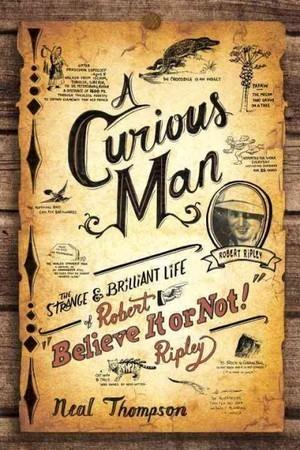
A Curious Man: The Strange and Brilliant Life of Robert “Believe It or Not!” Ripley
“We are talking about the guy who invented Ripley’s Believe It or Not! I would say Robert Ripley is a true American original. He invented himself, and along the way invented huge chunks of American culture. He was right there at the beginning of cartooning, tabloid news … So much of what we recognize as, you know, just the background of our lives and American culture — you know, sensationalism and celebrity news — Ripley was right there at the beginning of it. He built an entire entertainment conglomerate around himself. At one time he was, you know, an extremely wealthy man. He went all over the world in search of the exotic and the strange, and the weird, and he also had a pretty racy personal life. He had a harem long before Hugh Hefner ever thought of the Playboy Mansion.”
Taking What I Like: Stories by Linda Bamber
“Linda Bamber is a professor of English at Tufts University in Boston, and most of the stories in the collection take off from various Shakespeare plays — Othello, and Antony and Cleopatra,Henry IV, As You Like It. And she takes them in these amazing directions. In one story, the heroine of As You Like It leaves her play and ends up dating all the three principle men of Henry IV. In another, the entire cast of Othello is now a college English department, and Desdemona is the chairman, and Othello is the only minority member, and Iago is in there as well, you know, making trouble as always … I mean, I have never read anything quite like these stories. They have attitude, and they shake things up. They are playful, and inventive, and funny, and Bamber gets the entire world into each one of her stories.”
May 31, 2012
Ink, paper, tea, fizzy water, yard work… Ben Fountain talks about writing “Billy Lynn’s Long Halftime Walk”
My thanks to Ben Fountain for spending time to chat about Billy Lynn’s Long Halftime Walk for this Q&A at Amazon’s books blog, Omnivoracious.com. (Here)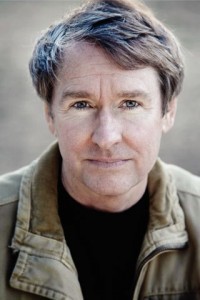
Ben’s debut novel – my favorite of the year so far - was an Amazon #1 Best Book of the Month for May. I had previously asked him about the book’s opening line (pictured below): “I wanted to drop you right into the middle things. I didn’t want to start with back story,” he told me by phone. “It just came to me and it felt right so I started from there.”
First line: The men of Bravo are not cold.
Last line: He sits back, closes his eyes, and tries to think about nothing as the limo takes them away.
And, for kicks, smack-dab in the middle: “This is crazy,” she whispers when they come up for air.
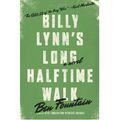 As I wrote in my review for Amazon, the author “manages a sly feat: giving us a maddening and believable cast of characters who make us feel what it must be like to go to war–and return. Veering from euphoria to dread to hope, Billy Lynn is a propulsive story that feels real and true. With fierce and fearless writing, Fountain is a writer worth every accolade about to come his way.”
As I wrote in my review for Amazon, the author “manages a sly feat: giving us a maddening and believable cast of characters who make us feel what it must be like to go to war–and return. Veering from euphoria to dread to hope, Billy Lynn is a propulsive story that feels real and true. With fierce and fearless writing, Fountain is a writer worth every accolade about to come his way.”
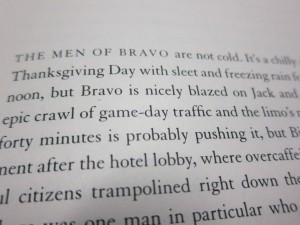
Here’s a 2008 New Yorker story by Malcolm Gladwell about Fountain – and late bloomers.
December 3, 2011
Getting schooled on suds by Garrett Oliver
My Amazon colleagues and I interview the author of The Oxford Companion to Beer.
September 17, 2011
More interviews at Amazon.com’s Omnivoracious
Three more of my author interviews at Amazon’s books blog:
-Chad Harbach, author of The Art of Fielding
-Laura Lippman, whose later novel is The Most Dangerous Thing
-George Pelecanos, whose latest is The Cut
And here’s a video interview I did with George in 2009, when he visited Seattle for his previous book, The Way Home:
Finally, here’s a book trailer by my friends Joe and Denice, for their new book, Signing Their Rights Away:
More interviews at Amazon.com's Omnivoracious
Three more of my author interviews at Amazon's books blog:
-Chad Harbach, author of The Art of Fielding
-Laura Lippman, whose later novel is The Most Dangerous Thing
-George Pelecanos, whose latest is The Cut
And here's a video interview I did with George in 2009, when he visited Seattle for his previous book, The Way Home:
Finally, here's a book trailer by my friends Joe and Denice, for their new book, Signing Their Rights Away:












